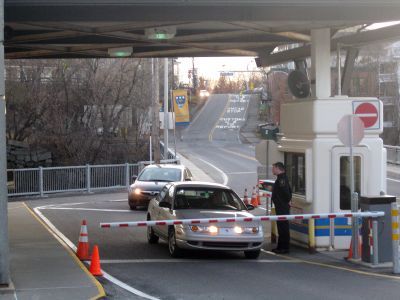'Passport please': new fences, new struggles for a border town

Canadians in Stanstead and Americans across the border in Derby Line, Vermont once lived in harmony as one community, mostly ignoring the imaginary line that separates them.
But all that changed six months ago when authorities started enforcing rules for travel between Canada and the United States: all must now pass through customs offices and show a valid passport.
And now, barricades also separate the two towns.
The change is most evident on Canusa Street. Homes on the north side are in Canada. On the south side is America. And it is no longer acceptable to go over to a neighbor across the street to ask to borrow their lawn mower.
"You have to register with US Customs and Border Protection at the end of the street, and stop in at the Canadian customs office when we return," says Raymond Fluet.
The 68-year-old has lived his entire life in this border town of 3,000, some 160 kilometers (90 miles) southeast of Montreal. He set up a hardware store behind his house.
"It used to be a friendly place. The people on both sides of the border, they're our parents, our friends, our cousins. This is home for all of us. But because of the crackdown, we don't go visit as often," he lamented.
This month, the townsfolk faced new obstacles: several streets on the border were blockaded.
"There was a lot of traffic. People used these roads to smuggle drugs, tobacco or alcohol, even illegal immigrants into the United States," said Philippe Dutil, the newly-elected mayor of Stanstead.
"It's for everyone's security," he said.
As part of larger effort to beef up US border security following the attacks of September 11, 2001, Washington ordered stricter controls along its northern frontier.
The Canada-US border remains the longest unmilitarized border in the world, but it is no longer as easy to cross.
Thorough searches await travelers at border crossings, while drones and armed guards now patrol along the 9,000 kilometer (5,592 mile) frontier.
"They apply the same rules as in the south, at its border with Mexico ... even though it is not the same circumstance," Fluet says.
The impact on the two border towns is significant. As most inhabitants do not have a passport, there are far fewer exchanges.
"It used to be practical to do some shopping in Quebec," Hanna Cornelius-Bouchard, who lives in Vermont with her husband and their two children, told AFP.
"But I'd rather spend my money on other things than four passports for the family ... so we haven't crossed the border in several months."
The lone structure spared in the divisive exercise is a library-opera house built on the border itself. The Victorian structure's front door is on the American side while its stage is on Canadian soil. A diagonal line on the floor indicates the border.
"The Canadians have one dispensation: they don't have to pass through customs if they park on their side of the border and do not stray from the sidewalk leading up to the building," said its director, American Nancy Rumery.
In case anyone does, there are surveillance cameras and regular patrols of the area.
But despite these new hardships, few want to move the border, even if local legend has it that hung over engineers placed it too far north.
sab/via/amc/jm
Join our commenting forum
Join thought-provoking conversations, follow other Independent readers and see their replies
Comments
Bookmark popover
Removed from bookmarks